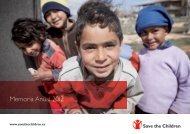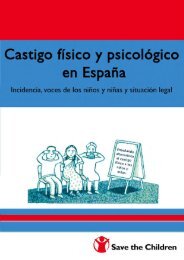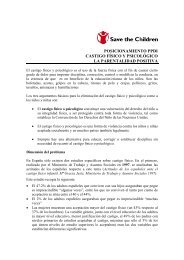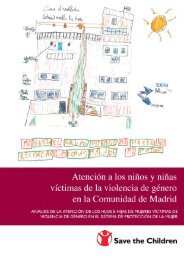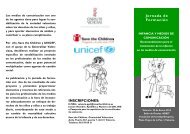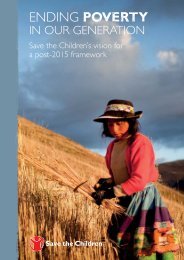Nutrition in the First 1,000 Days - Save the Children
Nutrition in the First 1,000 Days - Save the Children
Nutrition in the First 1,000 Days - Save the Children
You also want an ePaper? Increase the reach of your titles
YUMPU automatically turns print PDFs into web optimized ePapers that Google loves.
18 <strong>the</strong> gloBal MalNUtritioN criSiS<br />
Ris<strong>in</strong>g Food Prices Can<br />
hurt mo<strong>the</strong>rs and <strong>Children</strong><br />
As global food prices rema<strong>in</strong> high and<br />
volatile, poor mo<strong>the</strong>rs and children <strong>in</strong><br />
develop<strong>in</strong>g countries can have little choice<br />
but to cut back on <strong>the</strong> quantity and qual-<br />
ity of <strong>the</strong> food <strong>the</strong>y eat. The World Bank<br />
estimates that ris<strong>in</strong>g food prices pushed an<br />
additional 44 million people <strong>in</strong>to poverty<br />
between June 2010 and February 2011. 2011.37 37<br />
Staple food prices hit record highs <strong>in</strong><br />
February 2011 and may have put <strong>the</strong> lives of<br />
more than 400,<strong>000</strong> more children at risk. risk.38 38<br />
Poor families <strong>in</strong> develop<strong>in</strong>g countries<br />
typically spend between 50 to 70 percent<br />
of <strong>the</strong>ir <strong>in</strong>come on food. food.39 39 When meat,<br />
fish, eggs, fruit and vegetables become too<br />
expensive, families often turn to cheaper<br />
cereals and gra<strong>in</strong>s, which offer fewer<br />
nutrients. Studies show that women tend<br />
to cut <strong>the</strong>ir food consumption first, and as<br />
a crisis deepens, o<strong>the</strong>r adults and eventually<br />
children cut back.40 back. 40<br />
When pregnant mo<strong>the</strong>rs and young<br />
children are deprived of essential nutrients<br />
dur<strong>in</strong>g a critical period <strong>in</strong> <strong>the</strong>ir develop-<br />
ment, <strong>the</strong> results are often devastat<strong>in</strong>g.<br />
Mo<strong>the</strong>rs experience higher rates of anemia<br />
and chronic energy deficiency. Childbirth<br />
becomes more risky, and babies are more<br />
likely to be born at low birthweight.<br />
<strong>Children</strong> face <strong>in</strong>creased risk of stunt<strong>in</strong>g,<br />
acute malnutrition and death.<br />
BaRRieRs to BReastFeed<strong>in</strong>g<br />
Experts recommend that children be breastfed with<strong>in</strong> one hour of birth,<br />
exclusively breastfed for <strong>the</strong> first 6 months, and <strong>the</strong>n breastfed until age 2<br />
with age-appropriate, nutritionally adequate and safe complementary foods.<br />
Optimal feed<strong>in</strong>g accord<strong>in</strong>g to <strong>the</strong>se standards can prevent an estimated 19 percent<br />
of all under-5 deaths, more than any o<strong>the</strong>r child survival <strong>in</strong>tervention.41<br />
Yet worldwide, <strong>the</strong> vast majority of children are not breastfed optimally.<br />
What are some of <strong>the</strong> reasons for this? Cultural beliefs, lack of knowledge<br />
and mis<strong>in</strong>formation play major roles. Many women and family members are<br />
unaware of <strong>the</strong> benefits of exclusive breastfeed<strong>in</strong>g. New mo<strong>the</strong>rs may be told<br />
<strong>the</strong>y should wait several hours or days after <strong>the</strong>ir baby is born to beg<strong>in</strong> breastfeed<strong>in</strong>g.<br />
Aggressive market<strong>in</strong>g of <strong>in</strong>fant formula often gives <strong>the</strong> impression that<br />
human milk is less modern and thus less healthy for <strong>in</strong>fants than commercial<br />
formula. Or mo<strong>the</strong>rs may be told <strong>the</strong>ir breast milk is “bad” or does not conta<strong>in</strong><br />
sufficient nutrients, so <strong>the</strong>y <strong>in</strong>troduce o<strong>the</strong>r liquids and solid food too early.<br />
Most breastfeed<strong>in</strong>g problems occur <strong>in</strong> <strong>the</strong> first two weeks of a child’s life. If<br />
a mo<strong>the</strong>r experiences pa<strong>in</strong> or <strong>the</strong> baby does not latch, an <strong>in</strong>experienced mo<strong>the</strong>r<br />
may give up. Support from fa<strong>the</strong>rs, mo<strong>the</strong>rs-<strong>in</strong>-law, peer groups and health<br />
workers can help a mo<strong>the</strong>r to ga<strong>in</strong> confidence, overcome obstacles and prolong<br />
exclusive breastfeed<strong>in</strong>g.<br />
Women often stop breastfeed<strong>in</strong>g because <strong>the</strong>y return to work. Many aren’t<br />
provided with paid maternity leave or time and a private place to breastfeed<br />
or express <strong>the</strong>ir breast milk. Legislation around maternity leave and policies<br />
that provide time, space, and support for breastfeed<strong>in</strong>g <strong>in</strong> <strong>the</strong> workplace could<br />
reduce this barrier. For mo<strong>the</strong>rs who work <strong>in</strong> farm<strong>in</strong>g or <strong>the</strong> <strong>in</strong>formal sector,<br />
family and community support can help <strong>the</strong>m to cont<strong>in</strong>ue breastfeed<strong>in</strong>g, even<br />
after return<strong>in</strong>g to work. Also many countries need better laws and enforcement<br />
to protect women from persecution or harassment for breastfeed<strong>in</strong>g <strong>in</strong> public.<br />
Countries mak<strong>in</strong>g <strong>the</strong> Fastest and slowest ga<strong>in</strong>s aga<strong>in</strong>st<br />
Child malnutrition, ~1990-2010<br />
top 15 countries<br />
with fastest progress<br />
(annual % decrease <strong>in</strong> stunt<strong>in</strong>g)<br />
Bottom 15 countries<br />
with no progress<br />
(annual % <strong>in</strong>crease <strong>in</strong> stunt<strong>in</strong>g)<br />
Uzbekistan 6.7%<br />
angola 6.6%<br />
ch<strong>in</strong>a 6.3%<br />
Kyrgyzstan 6.3%<br />
turkmenistan 6.3%<br />
Dpr Korea 5.6%<br />
Brazil 5.5%<br />
Mauritania 4.6%<br />
eritrea 4.4%<br />
vietnam 4.3%<br />
Mexico 3.1%<br />
Bangladesh 2.9%<br />
Nepal 2.6%<br />
<strong>in</strong>donesia 2.6%<br />
cambodia 2.5%<br />
Sierra leone 0.0%<br />
Niger -0.2%<br />
Djibouti -0.4%<br />
Zimbabwe -0.5%<br />
lesotho -0.5%<br />
Burundi -0.5%<br />
gu<strong>in</strong>ea -0.8%<br />
Mali -0.9%<br />
yemen -1.0%<br />
central african republic -1.4%<br />
afghanistan -1.6%<br />
comoros -2.3%<br />
côte d'ivoire -2.6%<br />
Ben<strong>in</strong> -2.6%<br />
Somalia -6.3%<br />
-8% -6% -4% -2% 0% 2% 4% 6% 8%<br />
average annual rate of reduction <strong>in</strong> child stunt<strong>in</strong>g (%), ~1990-2010<br />
—<br />
Note: trend analysis <strong>in</strong>cluded all 71 of 75 Countdown countries with available data for <strong>the</strong> approximate period 1990-2010.<br />
For country-level data, see Methodology and research Notes. Data Sources: Who global Database on child growth<br />
and Malnutrition (who.<strong>in</strong>t/nutgrowthdb/); UNiceF global Databases (child<strong>in</strong>fo.org); countdown to 2015. Accountability for<br />
Maternal, Newborn & Child Survival: An Update on Progress <strong>in</strong> Priority Countries. (Who: 2012); recent DhS and MicS surveys (as<br />
of april 2012)







